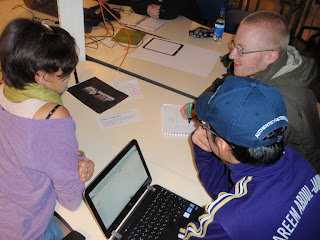 |
| Members of Group 7 |
Despite a lot of fallen comrades to sickness, Group 7 joined forces on Friday morning to give feedback to Group 1. Due to technical difficulties, we were secretly cackling and rubbing our hands together, thinking we would be allowed to have more time to prepare for feedback. But in the end it would be unfair to Group 1, who had so little time to prepare their presentation. If you think that two weeks to prepare a presentation for the hardest subject would hinder them, then we can say that was not the case, and that Group 1 really set the bar high for the upcoming groups.
The presentation started with a video showing snippets of Media in everyday life. With just a few images of familiar signs, logos, etc. it was clear to us that Media surrounds us and is part of our life. Following that, they interviewed people on the street about their definition of Media, Art, etc. which was a very nice way to introduce the topic and arise curiosity to those very same questions.
The theory part was only seven minutes long but still managed to cover the most important topics found on the book. The Social Media game was very fun, especially with the topics they chose. It also allowed us to have a glimpse of an aspect of professional life, that is problem solving in a group to cater to a target audience. The debate at the end of the class also raised interesting questions to something very actual, which is Social Media. It was also a good idea to explore it’s pros and cons.
Downsides: Considering the topic is “The Designs of Media” we believe Group 1 should have varied the theme a little bit more and not focus so much on Social Media. We would have kept the last debate that focused on Social Media, since it’s such an interesting actual topic, but could perhaps change the theme for the problem solving game. Maybe have something that would involve other fields of Media, like ask one group how would they make the masses go to the movies more often again, or how would they fight piracy on the music scene, etc.
We also think that it would be a good idea to include a conclusion with their own answers to the questions posed on the video. We agree that students should think for themselves, and come up with their own definition of what is Media, but sometimes in order for an idea to grow and bloom you must plant a seed. So, using Group 1’s own conclusion as starting point, the students could more easily come up with their own.
We believe Group 1 did an excellent job with their presentation, being engaging, asking for opinions, promoting debates and teaching in a fun way. It was a very good way to present, share and develop knowledge.













